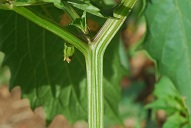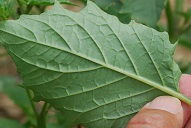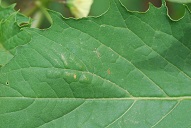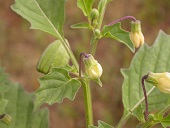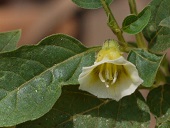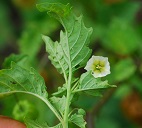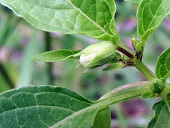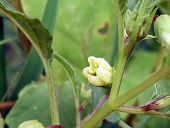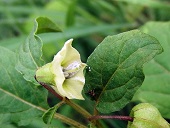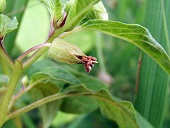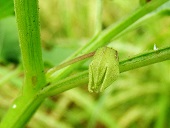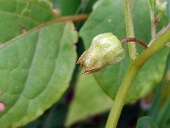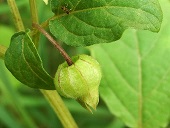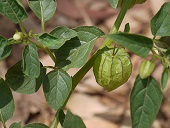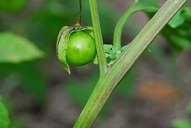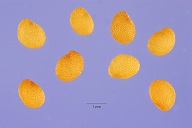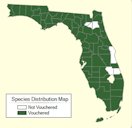| Cutleaf Groundcherry - Physalis angulata | |||||||||||||||||||||||||||||||||||
|---|---|---|---|---|---|---|---|---|---|---|---|---|---|---|---|---|---|---|---|---|---|---|---|---|---|---|---|---|---|---|---|---|---|---|---|
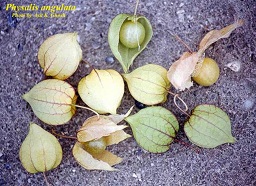 Fig. 1  Physalis angulata L. 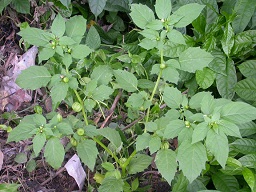 Fig. 2  Flowering and fruiting plant 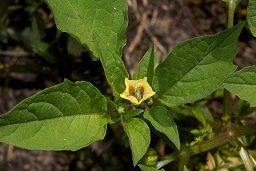 Fig. 6  Lake Urema Floodplain Edge, Gorongosa National Park, Zimbabwe 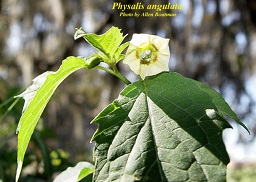 Fig. 7  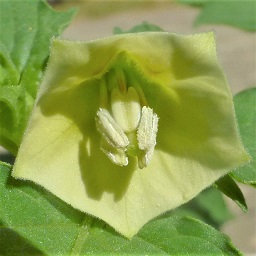 Fig. 8  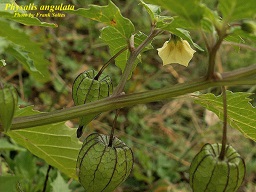 Fig. 19  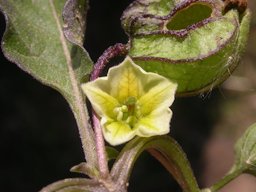 Fig. 20  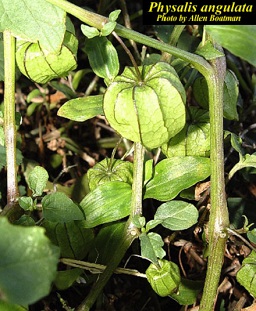 Fig. 21  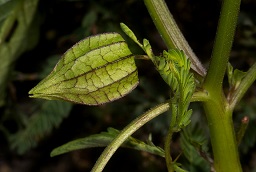 Fig. 22  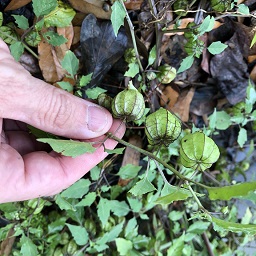 Fig. 23  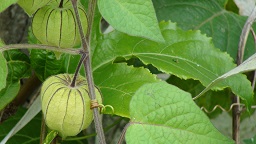 Fig. 24  Fruit almost ready to harvest 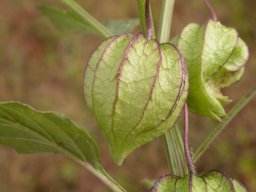 Fig. 25 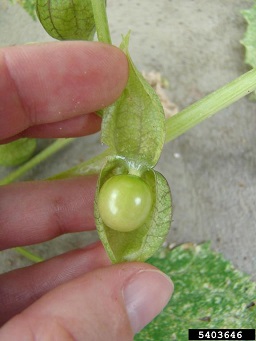 Fig. 26 Cutleaf groundcherry (P. angulata L.) immature fruit 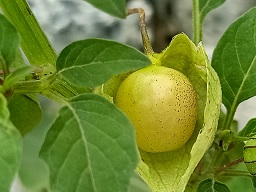 Fig. 27  P. angulata L. 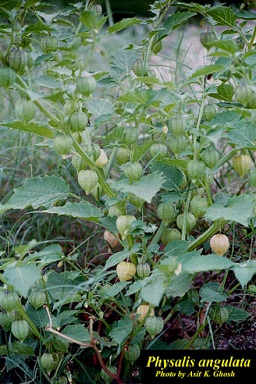 Fig. 31  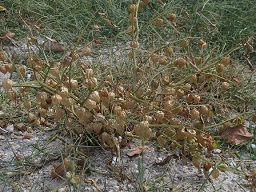 Fig. 32  Lots of ripe fruit 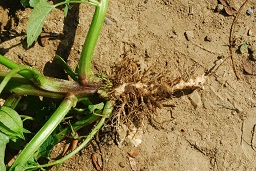 Fig. 33  P. angulata roots 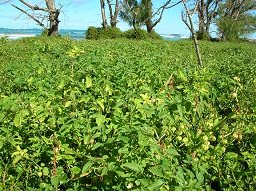 Fig. 34  P. angulata (husk tomato), habit, Mokuauia, Oahu, Hawai'i |
Scientific
name Physalis angulata L. Common names English: angular winter-cherry, balloon-cherry, cut-leaf ground-cherry, gooseberry, hogweed; French: coqueret, coqueret anguleux; Swedish: kantig lyktört; transcribed Chinese: ku zhi 1 Synonyms Boberella angulata (L.) E.H.L.Krause, Physalis angulata Ruiz & Pav., P. angulata angulata, P. angulata f. angulata, P. angulata f. linkiana (Nees) Stehlé, P. angulata f. ramosissima (Mill.) Stehlé, P. angulata var. angulata, P. angulata var. capsicifolia (Dunal) Griseb., P. angulata var. lanceifolia (Nees) Waterf., P. angulata var. linkiana (Nees) A.Gray, P. angulata var. normalis Kuntze, P. angulata var. pendula (Rydb.), Waterf.P. angulata var. ramosissima (Mill.) O.E. Schulz, P. angulata var. ramosissima (Mill.) Stehlé, P. capsicifolia (Dunal), P. esquirolii H. Lév. & Vaniot, P. glaberrima Colla, P. lanceifolia Nees, P. linkiana Nees, P. margaranthoides Rusby, P. pendula Rydb., P. ramosissima Mill. ex Dunal, P. surinamensis Miq.,Saracha angulata M.Martens & Galeotti 2 Relatives Clammy ground cherry (P. heterophylla), tomatillo (P. ixocarpa), purple ground cherry (P. philadelphica), strawberry tomato (P. pruinosa), ground cherry, husk tomato (P. pubescens), sticky ground cherry (P. viscosa). There is considerable confusion in the literature concerning the various species. Hybrids between them are also known. 8 Family Solanaceae (nightshade family) Origin Native to Northern and Southern America 1 USDA hardiness zones 9-11 Uses Eaten raw or cooked; made into marmalade Height Up to 3.3 ft (1 m) in height 3 Spread Low spreading with long horizontal stems 6 Longevity Herbacious annual 2 Trunk/bark/branches Usually hairless; however, occasional plants have short appressed hairs especially on the younger parts 3 Leaves Dark green; roughly oval; often with tooth shapes around the edge 4 Flowers Five-sided; pale yellow with maroon eye; 0.5 in. (1.25 cm) wide 4,6 Fruit Berry; juicy; sub-acid; yellow-orange fruits nearly filling a balloon-like calyx 4,5 Light requirement Prefers full sun; tolerant of partial shade 7 Soil tolerances Grows best in moist, well-drained sandy loam soil 7 Cold tolerance Damaged at 19 °F (-7 °C) Roots Long taproot Invasive potential * None reported Known hazard Eating too much of the fruit may cause dizziness; in large quantites it is poisonous to cattle and sheep Origin It is native to the Americas, but is now widely distributed and naturalized in tropical and subtropical regions worldwide. 4 Is indigenous to many parts of the tropics, including the Amazon. It can be found on most continents in the tropics, including Africa, Asia, and the Americas. 7 P. angulata is a plant of urban open spaces, disturbed areas, roadsides, croplands, orchards, nurseries and fallow land. 7 Sorting Physalis names, Multilingual Multiscript Plant Name Database ext link Description Erect herb with smooth, deeply serrated leaves. Yellow flowers and green "Chinese lantern" puffy fruits, like Cardiospermum but pointed sharply at the bottom. 10 A wild species that takes to home gardening very well is Physalis angulata, the Cutleaf Ground Cherry. It’s tall and prolific under cultivation. 9 Leaves The leaves are less oblique, more dentate, ovate to lanceolate, 1.5-4 In. (4-10 cm) long and 1-2.5 in. (3-6 cm) wide. The petioles are up to 1 in. (4 cm) long or longer. The leaf margin is usually irregularly toothed but may be smooth. The leaf bases are unequal. 7 It is usually hairless; however, occasional plants have short apprised hairs especially on the younger parts. 7
Fig. 3. P. angulata, stem and node Fig. 4. Leaf lower surface Fig. 5. Leaf upper surface Flowers The flowers are borne on stalks from 0.2-1.6 in. (5-40 mm) in length. The corolla is yellow, usually without spots or occasionally with distinct spots, and is from 0.16-0.47 in. (4-12 mm) long and 0.24-0.47 in. ( 6-12 mm) wide. The anthers are bluish or violet, up to 0.98 in. (2.5 mm) long and are borne on stalks up to 0.2 in. (5 mm) long. The green outer layer is 1.6-0.28 in. (4-7 mm) long with triangular lobes about as long as the tube. 7
Fig. 9. P. angulata L., flowers nodding; corolla pale yellow towards apex, greenish yellow toward the base Fig. 11. Corolla interior lacking dark center From flower to fruit sequence
Fruit Produces small, light yellowish-orange, edible fruit sometimes referred to as cape gooseberry or cut leaf ground cherry. 7 The fruit is about the size of a cherry tomato, and like tomatoes, it contains many tiny edible seeds inside. The fruit is enclosed in the outer layer. This outer layer (calyx) grows around and encloses the fruit, becomes 10-angled or ribbed. The fruit is succulent in nature and tangy in taste although sometimes it may be bitter (Reddy KN et al., 2007), (Sachidananda and Prasad, 1996). 7 The calix is inedible.
Fig. 29. P. angulata, stem and fruit; stem glabrous, berry green Food Uses Ripe fruit edible raw or cooked. Dr. Howard found them excellent fried or stewed and made a fine 'marmalade' by cooking them in palm sirup. The leaves are reportedly cooked as green in central Africa. 6 Medicinal Properties ** Ethno Medicinal, Phyto Chemical and Therapeutic Importance of Physalis angulata L.: A Review, International Journal of Science and Research pdf Other Edible Physallis species: Cape Gooseberry, Physalis peruviana Coastal Groundcherry, Physalis angustifolia, University of Florida pdf Ground Cherry, Wild Husk Tomatoes, Almost, Eat The Weeds Tomato, Husk, Physalis pruinosa L., University of Florida pdf Tomatillo, Physalis philadelphica General The genus name Physalis, a Greek word, means bladder and refers to the inflated calyx, while the Latin species name angulata means angled and refers to the stems or the angled nature of calyx. 3
Fig. 35. Cutleaf ground cherry distribution map, wild populations List of Growers and Vendors |
||||||||||||||||||||||||||||||||||
| Bibliography 1 "Taxon: Physalis angulata L. common names." USDA, Agricultural Research Service, National Plant Germplasm System, Germplasm Resources Information Network (GRIN-Taxonomy), National Germplasm Resources Laboratory, Beltsville, Maryland, 2019, npgsweb.ars-grin.gov/gringlobal/taxonomydetail.aspx?id=102388. Accessed 4 Sept. 2019. 2 "Physalis angulata L. synonyms." The World Flora Online, WFO, Public Domain, worldfloraonline.org/taxon/wfo-0001024566. Accessed 19 Apr. 2023. 3 Hall, D. W, et al. "Cutleaf Ground-cherry, Physalis angulata L." Weeds in Florida, UF/IFAS Extension, SP 37, Original pub. May 1991, Revised Mar. 2006, Archived, AskIFAS, edis.ifas.ufl.edu/fw031. Accessed 4 Sept. 2019. 4 "Physalis angulata." Wikimedia, en.wikipedia.org/w/index.php?title=Physalis_angulata&oldid=825574782. Accessed 19 Sept. 2019. 5 "Physalis angulata Linnaeus." Flora of China, www.efloras.org/florataxon.aspx?flora_id=2&taxon_id=200020561. Accessed 4 Sept. 2019. 6 Morton, Julia. "Wild Plants for Survival in South Florida." Proceedings of the Florida State Horticultural Society, Krome Memorial Institute (Tropicals), 12 June 1962, Florida State Horticultural Society, journals.flvc.org/fshs/article/view/101030/96974. Accessed 19 Sept. 2019. 7 Ayodhyareddy, P., and P. Rupa. "Ethno Medicinal, Phyto Chemical and Therapeutic Importance of Physalis angulata L.: A Review." International Journal of Science and Research, 5 May 2016, IJSR, (CC BY), pdfs.semanticscholar.org/275d/d5737523e676e9a1d2ad651bffcffd92e62c.pdf. Accessed 19 Sept. 2019. 8 "Cape Gooseberry, Physalis peruviana L." California Rare Fruit Growers, crfg.org.pubs/ff/cape-gooseberry.html. Accessed 10 Sept. 2019. 9 Deane, Green. "Ground Cherry, Wild Husk Tomatoes, Almost." Eat the Weeds and other things, too, www.eattheweeds.com/physalis-tomatos-wild-cousin-2/. Accessed 2 Sept. 2019. 10 Wursten, BT. "Physalis angulata L. Erect herb with smooth, deeply serrated leaves. Yellow flowers and green "Chinese lantern" puffy fruits, like Cardiospermum but pointed sharply at the bottom." Flora of Zimbabwe, Lake Urema Floodplain Edge, Gorongosa National Park, no. 24446, 17 May 2015, www.zimbabweflora.co.zw/speciesdata/image-display.php?species_id=150510&image_id=4. Accessed 21 Sept. 2019. Photographs Fig. 1,31 Ghosh, Asit K. "Physalis angulata." Institute for Systematic Botany, University of South Florida, Tampa, S. M. Landry and K. N. Campbell (application development), USF Water Institute, 2019, Atlas of Florida Plants, florida.plantatlas.usf.edu/photo.aspx?ID=2845. Accessed 4 Sept. 2019. Fig. 2 Scamperdale. "Flowering and fruiting plant." Tropical Plants Database, (CC BY-NC 2.0), tropical.theferns.info/viewtropical.php?id=Physalis+angulata. Accessed 4 Sept. 2019. Fig. 3 Turner, Steve R. "Physalis angulata, Stem and node." Tropicos.org, Missouri Botanical Garden, 8 Oct. 2014, Tropicos®, (CC BY-NC-ND 3.0), www.tropicos.org/Image/100398993.htm. Accessed 12 Sept. 2019. Fig. 4 Turner, Steve R. "Physalis angulata, Leaf lower surface." Tropicos.org, Missouri Botanical Garden, 8 Oct. 2014, Tropicos®, (CC BY-NC-ND 3.0), www.tropicos.org/Image/100398991.htm. Accessed 12 Sept. 2019. Fig. 5 Turner, Steve R. "Physalis angulata, Leaf upper surface." Tropicos.org, Missouri Botanical Garden, 8 Oct. 2014, Tropicos®, (CC BY-NC-ND 3.0), www.tropicos.org/Image/100398992.htm. Accessed 12 Sept. 2019. Fig. 6 Wursten, BT. "Physalis angulata L. Erect herb with smooth, deeply serrated leaves. Yellow flowers and green "Chinese lantern" puffy fruits, like Cardiospermum but pointed sharply at the bottom." Flora of Zimbabwe, Lake Urema Floodplain Edge, Gorongosa National Park, no. 24445, 1 May 2019, www.zimbabweflora.co.zw/speciesdata/image-display.php?species_id=150510&image_id=3. Accessed 21 Sept. 2019. Fig. 7,21 Boatman, Allen. "Physalis angulata." Institute for Systematic Botany, University of South Florida, Tampa, S. M. Landry and K. N. Campbell (application development), USF Water Institute, 2019, Atlas of Florida Plants, florida.plantatlas.usf.edu/photo.aspx?ID=2845. Accessed 4 Sept. 2019. Fig. 8 sehnature. "Cutleaf Groundcherry Physalis angulata L." INaturalist Research-grade Observations, Global Biodiodiversity Information Facility, no. 31843533, 25 Aug. 2019, GBIF, (CC BY-NC 4.0), www.gbif.org/occurrence/2397645066. Accessed 21 Sept. 2019. Fig. 9 Gerrit, Davidse. "Physalis angulata L., Flowers nodding; corolla pale yellow towards apex, greenish yellow toward the base." Tropicos.org, Missouri Botanical Garden, United States, Missouri, Perry, no. 38527, 20 Sept. 2011, Tropicos®, (CC BY-NC-SA 3.0), www.tropicos.org/Image/100169753. Accessed 12 Sept. 2019. Fig. 10,28 Valke, Dinesh. "Physalis angulata L." 3 April 2010, Commons Wikimedia, (CC BY-SA 2.0), commons.wikimedia.org/wiki/File:Physalis_angulata_L._(16340322250).jpg. Accessed 12 Sept. 2019. Fig. 11 Turner, Steve R. "Physalis angulata, Corolla interior lacking dark center." Tropicos.org, Missouri Botanical Garden, Tropicos®, (CC BY-NC-ND 3.0), Image cropped, www.tropicos.org/Image/100208352.htm. Accessed 12 Sept. 2019. Fig. 12,13,14,15,16,17,18 大肚魚. "Cutleaf Groundcherry Physalis angulata L." INaturalist Research-grade Observations, Global Biodiodiversity Information Facility, 28 June 2019, GBIF, (CC BY-NC 4.0), www.gbif.org/occurrence/2283099539. Accessed 21 Sept. 2019. Fig. 19 Soltes, Frank. "Physalis angulata." Institute for Systematic Botany, University of South Florida, Tampa, S. M. Landry and K. N. Campbell (application development), USF Water Institute, 2019, Atlas of Florida Plants, florida.plantatlas.usf.edu/photo.aspx?ID=2845. Accessed 4 Sept. 2019. Fig. 20,25 Gerrit, Davidse. "Physalis angulata L." World Flora Online, (CC BY-NC-SA 3.0), worldfloraonline.org/taxon/wfo-0001024566. Accessed 19 Apr. 2023. Fig. 22 Wursten, BT. "Physalis angulata L. Erect herb with smooth, deeply serrated leaves. Yellow flowers and green "Chinese lantern" puffy fruits, like Cardiospermum but pointed sharply at the bottom." Flora of Zimbabwe, Lake Urema Floodplain Edge, Gorongosa National Park, no. 24446, 17 May 2015, www.zimbabweflora.co.zw/speciesdata/image-display.php?species_id=150510&image_id=4. Accessed 21 Sept. 2019. Fig. 23 howardhome. "Cutleaf Groundcherry Physalis angulata L." INaturalist Research-grade Observations, Global Biodiodiversity Information Facility, no. 34379331, 8 Apr. 2019, GBIF, (CC BY-NC 4.0), www.gbif.org/occurrence/2236257929. Accessed 21 Sept. 2019. Fig. 24 Gold, Bernard. "Fruit almost ready to harvest." Tropical Plants Database, (CC BY-NC 2.0), tropical.theferns.info/viewtropical.php?id=Physalis+angulata. Accessed 4 Sept. 2019. Fig. 26 Wallace, Rebekah D. "Cutleaf groundcherry (Physalis angulata) L." University of Georgia, Bugwood.org, 5403646, Uploaded 21 Sept. 2009, Updated 22 Sept. 2009, Bugwood.org, (CC BY-NC 3.0 US), www.forestryimages.org/browse/subthumb.cfm?sub=6168&cat=56. Accessed 12 Sept. 2019. Fig. 27 Ong Jyh Seng. "Cutleaf Groundcherry Physalis angulata L." INaturalist Research-grade Observations, Global Biodiodiversity Information Facility, no. 31106111, 19 Aug. 2019, GBIF, (CC BY-NC 4.0), www.gbif.org/occurrence/2397505655. Accessed 21 Sept. 2019. Fig. 29 Turner, Steve R. "Physalis angulata, Stem and fruit. Stem glabrous, berry green." Tropicos®, (CC BY-NC-ND 3.0), Pacific Island Ecosystems at Risk (PIER), hear.its.hawaii.edu/pier/imagepages/singles/tropicos_100208354.htm. Accessed 12 Sept. 2019. Fig. 30 Hurst, Steve. "Physalis angulata L. cutleaf groundcherry." USDA, NRCS, National Plant Data Team, Greensboro, NC 27401-4901 USA, 2019, The PLANTS Database, plants.usda.gov. Accessed 20 Sept. 2019. Fig. 32 Zona, Scott. "Lots of ripe fruit." Tropical Plants Database, (CC BY-NC 2.0), tropical.theferns.info/viewtropical.php?id=Physalis+angulata. Accessed 4 Sept. 2019. Fig. 33 Turner, Steve R. "Physalis angulata, Roots." Tropicos.org, Missouri Botanical Garden, 8 Oct. 2014, Tropicos®, (CC BY-NC-ND 3.0), www.tropicos.org/Image/100398997.htm. Accessed 12 Sept. 2019. Fig. 34 Starr, Forest and Kim. "Physalis angulata (Husk tomato), Habit, Mokuauia, Oahu, Hawaii." no. 050222-4123, 22 Feb. 2005, Starr Environmental, (CC BY 4.0), www.starrenvironmental.com/images/image/?q=24109556964. Accessed 5 Sept. 2019. Fig. 35 "Physalis angulata, Species Distribution Range." Institute for Systematic Botany, University of South Florida, Tampa, S. M. Landry and K. N. Campbell (application development), USF Water Institute, 2019, Atlas of Florida Plants, florida.plantatlas.usf.edu/photo.aspx?ID=2845. Accessed 4 Sept. 2019. * UF/IFAS Assessment of Non-native Plants in Florida's Natural Areas ** The information provided above is not intended to be used as a guide for treatment of medical conditions using plants. Published 23 Sept. 2019 LR. Last update 20 Apr. 2023 LR |
|||||||||||||||||||||||||||||||||||
